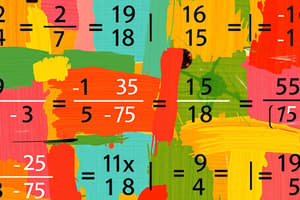Podcast
Questions and Answers
What is the primary goal of simplifying fractions?
What is the primary goal of simplifying fractions?
- To obtain the fraction in its highest form
- To make the fraction more visually appealing
- To perform arithmetic operations quickly and efficiently
- To reduce the complexity of the fraction (correct)
Which of the following is the correct definition of coprime numbers?
Which of the following is the correct definition of coprime numbers?
- Positive integers that have a common divisor of 2
- Positive integers that have a common divisor of 1
- Positive integers that have no common divisor other than 1 (correct)
- Positive integers that have a common divisor of 3
What is the first step in simplifying a fraction?
What is the first step in simplifying a fraction?
- Divide the numerator and denominator by the lowest common multiple
- Divide the numerator and denominator by the lowest common factor
- Identify the highest common factor (HCF) between the numerator and denominator (correct)
- Multiply the numerator and denominator by the highest common factor
What is the result of simplifying the fraction $12/24$?
What is the result of simplifying the fraction $12/24$?
Which of the following statements about simplifying fractions is true?
Which of the following statements about simplifying fractions is true?
What is the purpose of simplifying fractions?
What is the purpose of simplifying fractions?
What is the simplified fraction of 12/24?
What is the simplified fraction of 12/24?
What is the simplified fraction of 92/166?
What is the simplified fraction of 92/166?
What is the simplified fraction of $(2x^2 * y)/(xy)$?
What is the simplified fraction of $(2x^2 * y)/(xy)$?
What is the simplified fraction of $(2^2)^3/(2^3)^2$?
What is the simplified fraction of $(2^2)^3/(2^3)^2$?
Which of the following is the correct way to simplify a fraction?
Which of the following is the correct way to simplify a fraction?
Study Notes
Simplifying Fractions: Mastering the Essential Math Skill
Fractions are an integral part of mathematics and are used extensively in everyday life to measure quantities. However, not every fraction is presented in its simplest form. Simplifying fractions refers to the process of writing a fraction as a ratio of two coprime integers. Coprime numbers are positive integers that have no common divisor other than 1. The goal of simplifying fractions is to obtain the fraction in its lowest form, often referred to as the simplest form. This not only reduces the complexity of the fraction but also aids in performing arithmetic operations quickly and efficiently.
To simplify a fraction, follow these steps:
-
Identify the highest common factor (HCF):: Find the largest number that divides both the numerator and the denominator without leaving any remainder. This is the highest common divisor between the two numbers. For example, for the fraction 12/24, the HCF is 12 itself.
-
Divide the numerator and denominator by the HCF: Divide the numerator and the denominator separately by the HCF. The result will be a new fraction with the same value but the factors are reduced. Continuing with the above example, after dividing the numerator and denominator by 12, we get 1/2.
Remember, the simplified fraction is equivalent to the original fraction, so the value remains the same despite the changes.
Here are a couple of examples illustrating the process of simplifying fractions:
Example 1: Simplify the fraction 12/24. Since the HCF of 12 and 24 is 12, divide both the numerator and denominator by 12: 12 ÷ 12 = 1 24 ÷ 12 = 2 Now the simplified fraction is 1/2.
Example 2: Simplify the fraction 92/166. The HCF of 92 and 166 is 92. Dividing both the numerator and denominator by 92 gives us 1/2. So, the simplified fraction is 1/2.
Example 3: Simplify the fraction (2x^2 * y)/(xy). Write the factors of x^2 and y separately: 2x^2 = 2*(x^2)^1 and (2xy)/(xy) = 2*(x^2)^0*(y^1)^1. Multiplying these together gives us (2x)(2y) = 4xy. Thus, the simplified fraction is 4xy/xy = 4.
Exponents in fractions work similarly. Use the expanded form of exponents in the numerator and denominator to make it easier to simplify the fraction. For example, (2^2)^3/(2^3)^2 = 64/(2^2)/(2^3) = 64/(4)= 16.
Studying That Suits You
Use AI to generate personalized quizzes and flashcards to suit your learning preferences.
Description
Learn how to simplify fractions by identifying the highest common factor (HCF) and dividing the numerator and denominator by it. Simplifying fractions involves reducing a fraction to its simplest form by expressing it as a ratio of coprime integers, aiding in easier arithmetic operations. Practice simplifying fractions through step-by-step examples and understand how to handle fractions with exponents in this essential math skill quiz.




